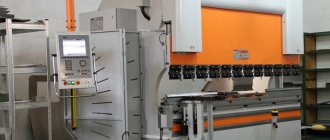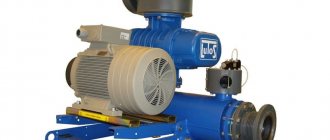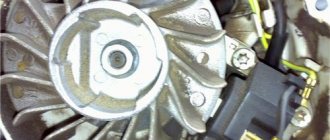Any type of firewood is suitable to keep the fire burning. It is better to light a stove or fireplace with small logs. To prepare them you will need a good ax. This is the most common tool in household use. It takes a lot of effort to prepare firewood for the entire winter. After cutting the stumps, calluses may appear on the hands, and many people’s backs begin to ache. There is a way out. Modern technologies make it possible to automate this hard work. A wood splitter will come to the rescue.
There is a wide range of manual and electric wood splitters on the modern market. These devices make human work easier. They will help you get a lot of work done in a short time. The tool minimizes physical stress and saves a lot of time. There will be no need to swing a heavy ax or cleaver when cutting thick stumps. The hydraulic device will do the most difficult work. It will split wood of any diameter into equal logs.
The editors of the site have compiled a rating of the best wood splitters. Experts took into account reviews from professionals and the opinions of ordinary users. Based on them, recommendations are made that will help you make a choice. There are a large number of manufacturers from different countries on the market who compete with each other. The best models that are worth focusing on have been selected.
The principle of operation of the wood splitter
Seeing a wood splitter for the first time, the consumer wonders: how does it work?
The standard work scheme consists of several stages, including:
- Laying logs in the spaces of the feed chutes. The designs of these elements contain special blades and movable pistons.
- Pushing logs towards the blades using movable pistons.
- Splitting logs into pieces using blades. In this case, the number of parts will depend on how many blades the unit contains.
In general, you can see that the operation scheme of the tool is very simple.
Even an inexperienced beginner can handle a wood splitter; the main thing is to follow safety precautions and work strictly according to step-by-step instructions.
Mechanical spring cleaver
A modified version of the hand cleaver is a mechanical spring device. The wood splitter operates on the principle of centrifugal force, the main purpose of the design is to hold the splitter with an impressive mass at the end of the cycle. The spring must be made movable to adjust the force applied to stop the cleaver. A device made by yourself must have a height corresponding to a person’s height for the least load.
Spring mechanical wood splitter
Making a log clamp is for safety reasons. The frame mechanism experiences constant loads, so it is necessary to make it from double material. For possible mobility, it is possible to install wheels on one of the sides for movement.
Types of wood splitters
To fully understand what kind of wood splitter you need, you need to study the list of existing types of tools.
This list includes:
- Mobile wood splitter. From the name it is clear that the device can be moved. To do this, it is equipped with several wheels, and some may have small weight indicators, which will allow you to move it manually.
- Stationary model. This is the opposite of the previous version, because such a tool cannot be moved anywhere. They have high mass values and are also large in size. As a rule, such models are used in industrial activities by professionals.
- Manual variety. Everything is simple here; firewood is collected manually. Typically, such designs have one blade and a stand. Of course, such devices allow you to chop only one log at a time.
- Crowbar splitters. These tools are similar to a regular crowbar, and the process of use is also done manually.
- Spring model. The design of such a tool is made in the form of a lever, one side of which contains blades, and the other is secured with a frame.
- Mechanical view. It uses motors and the shafts contain tapered screws. The logs are pricked, precisely, with the help of these screws, which are smoothly screwed into the logs and divide it into several even parts.
- Cone model. It is no different from the previous type, but instead of screws there is a conical device.
- Geared wood splitters. The use of a special gearbox allows you to reduce the speed of the cone device.
- Electric models. From the name it is clear that the work occurs by connecting to electrical networks. Such models are very popular among consumers because they do not create waste and are highly efficient.
- Gasoline variety. It uses internal combustion engines that run on gasoline fuel. They are used for splitting very large firewood, because the engine power here is much greater than that of its electric counterparts.
Tools powered by tractor traction. Most often they are used in agriculture where there are tractors. The operating process is directly related to the hydraulic system of tractors or their torque shafts.
Rating of popular models
Manual wood splitter: Kolundrov - “X4” “X4-5”.
- Wood splitter from a domestic manufacturer.
- It has a mass of 6.5 kg and a stable design.
- The model will allow you to simply and effortlessly prepare wood for fireplaces or barbecues.
It consists of 2 sharp blades, which are arranged crosswise and allow you to split logs into 4 logs. To hit the log from above, you will have to use a sledgehammer.
The price ranges from 7500 to 8000 rubles.
Electric wood splitter AL-KO LSV 7
This is a professional device. Its vertical design splits logs up to one meter long.
The table height has three positions depending on the length of the wood material:
- 0.56 m;
- 0.81 m;
- 1.03 m.
An engine with a power of three kW creates a pressing force of 7 tons. This device has the highest safety characteristics.
The only negative is the price: about 115,000 rubles.
Model – CHAMPION LSH5001
Powered by electricity, power 2.2 kW. Presses with a force of 5 tons. It has a long power cord and a durable frame. The maximum length of a log that the machine can split is 52 cm.
- This Chinese wood splitter is mobile because... has a small weight (45 kg). A hydraulic system filled with oil.
- A reliable and safe unit, the start lever of which is protected by a metal visor.
Among the shortcomings, users note: plastic wheels and the absence of rubber handles for moving the wood splitter. This creates certain inconveniences, but does not in any way affect the performance of the unit.
The price of the device is approximately 24,000 rubles.
German wood splitter AL-KO KHS 5204
It has a horizontal design and high-quality assembly and a well-adjustable frame in height. The power of the electric motor is 2.2 kW, the pressing force is 5 tons. It chops wood material 0.25 cm long and 52 cm in diameter logs.
Disadvantages: low labor productivity, unstable when working with large logs.
The price is around 30,000 rubles.
Chinese wood splitter RedVerg RD-LS 25-37E
The most affordable option for a household electrical appliance. Easy to use, lightweight and compact.
The pressing force is 4 tons, and the maximum length of wood is 34 cm, and the diameter is 25 cm. It does not have an attachment for dividing logs into 4 parts. Safe to handle, because has two-hand control.
Price from 20,000 to 23,000 rubles.
Characteristics of the wood splitter
In addition to existing models, you need to understand what technical characteristics the tool should have.
This list includes:
- Dimensional indicators. Please note that each model may have different dimensions.
- Engine power indicators. Whether it is electric or gasoline engines, you need to select devices with a power rating for your tasks.
- Cleavage power indicators. How much pressure the device will put on the block depends on this.
- Indicators of working length and diameter. This is a very important parameter, because some models simply cannot cope with large diameter logs.
- Piston strokes and speed indicators.
When you need less wood
For splitting logs into firewood in milder climates or for heating a small building, a screw splitter is most suitable. Its productivity is low; using it requires a certain skill and fairly strong hands. But, contrary to popular belief, a screw wood splitter is not very sensitive to block defects, because its working body splits the tree, screwing into it and sawing. As a result, a screw wood splitter is also economical: with a 2.5-3 kW motor it can chop logs up to 40 cm in diameter and 60 cm in height; with a motor from a washing machine - more or less straight-layered with a diameter of up to 20-25 cm.
Note: many people make screw wood splitters with motors from washing machines, especially since the rotation speed is suitable, see below. But in this case there is no need to place the cleaver directly on the motor shaft - from lateral forces the motor housing, which is not designed for them, will soon move or, if it is silumin, it will crack. The cleaver must be placed on the drive shaft in supports, and it must be connected to the engine shaft with a damping transmission or coupling, for example. from a piece of durite hose.
The device of a screw wood splitter is shown on the left in Fig. The working body is a conical screw with a shaped persistent left-hand thread; rotation speed 150-1500 rpm (optimally 250-400). Why is the thread left-handed? Mainly because most people are right-handed and their right hand is stronger; If you are left-handed, then it will be much more convenient and safer for you to work with a right-handed screw cleaver.
Design and principle of operation of a screw wood splitter
The churak is fed vertically onto the screw cleaver, otherwise the situation shown below on the right in Fig. Churak must be held with his hands (above right), so a screw-type wood splitter is a potentially dangerous device. The right hand, which is stronger and more dexterous (for left-handed people, the left hand) keeps the rest of the block from being pulled under by the cleaver (the wedge stop is also important in this regard, see below), which inevitably causes irreparable damage to the mechanism and almost always injury to the operator. Therefore, you need to chop off the logs from the part of the log that is under your left hand (right for left-handers), and make sure that there is not too little left under your right (left). If a cleaver encounters a viscous place in the mass of wood (a knot, a twist), it can, as it were, wrap a block around itself from above and bend downward; a wedge stop under the cleaver prevents this situation.
Design Features
Safety, productivity and ease of use of a screw wood splitter with the same motor strongly depend on the rational design and its correct execution of such structural components as the wedge stop, the drive mechanism, the drive shaft and its support. The efficiency of a screw log splitter is more influenced by the configuration of the splitter.
Emphasis
The wedge stop is a critical element of the entire structure. Its absence or incorrect implementation not only makes the wood splitter dangerous, but also reduces its performance, reliability and capabilities: a wood splitter with an incorrect stop takes smaller ones, slower, and itself wears out faster and breaks down more often.
Leaving the cleaver hanging high without a lower stop, and even with the drive shaft supported only by bearings (on the left in the figure) is a gross mistake. There are more than enough opportunities to pull a piece of wood under yourself and tear yourself out of the weak supports along with the bent shaft here, but it is difficult to split a block of wood by gnawing into it high above the lower cut. But a simple steel plate instead of a stop (in the center) is no better: with the lateral forces that arise when chopping, it doesn’t matter whether it’s 4 mm steel or cardboard.
Incorrect and correct design of the wedge stop of a screw wood splitter
The correct wedge stop for a screw wood splitter is a massive all-metal one, securely attached to a strong frame, on the right. The length of the stop is such that the nose of the cleaver is free by 1/3-1/2 of the length of the threaded part. The width of the stop along its entire length is equal to the diameter of the splitting ax in this section minus 3-4 thread heights, see below. The gap between the stop and the shank of the cleaver is no more than 1.2-2 mm; It’s better if you can make a gap of 0.5-0.7 mm; Let the cleaver rub a little against the stop while working, no big deal, but it will last a long time and reliably. Stop height approx. 2/3 of the diameter of the cleaver shank; for 75 mm within 50-60 mm.
The essence of the action of such a stop is that the grabbing and pulling of the block at the beginning of the working stroke is easily countered with your hands. When the cleaver is sufficiently screwed into the tree, you can no longer hold the grabbed block with your hand. But in this case, the bottom of the pulled-up part will hit the side of the stop; Perhaps it will break off and fly off. Grabbing the part of the block under the right hand will weaken and will not turn the cleaver upward, and grabbing the left part will press it against the stop. If the drive and drive shaft holder are made correctly, the mechanism will stop and the situation will not develop into a threatening situation.
Drive unit
The external characteristics of a screw-type log splitter have an unpleasant feature, similar to that of a rack-and-pinion splitter - zero thread travel with zero rotation. Only here it is not the lath that is pushed away by the tribe, but the cleaver that pulls the block under itself. At the same time, if a cleaver encounters a sticky obstacle in a tree, in most cases it is enough for him to break through first, then he will go to saw a branch or strand, although more slowly. In this case, the inertia of the drive can help: for a moment, the wood splitter turns into a mechanical impact one.
Variants of the screw wood splitter drive
Inertia for rotation is provided by a belt drive with a fairly massive driven pulley, on the left in the figure, but without additional safety elements (see below), this solution is questionable: if the “plug” is not torn off, and the flywheel pulley is heavy, then the entire mechanism may break and a dangerous situation will arise. Much better in this regard is the chain drive, on the right in Fig. The chain itself is heavy, and because of the play in the joints of its links, one strong, fairly long jerk is broken into a series of sharp, frequent ones, and the cleaver overcomes the “plug” more easily. Compare: what is the best way to drive a nail into a wall without bending it - hit it once with a backhand or with frequent small blows?
Drive shaft support
The inertia of the chain is still low, and if you have to chop clumsy logs, it is still advisable to equip the wood splitter with a mechanical energy storage device in the form of a massive driven belt pulley. The safety of the device is then ensured by introducing a known weak link into the supporting structure of the shaft.
Assembly drawing of the supporting structure of the drive shaft of a screw wood splitter
An example of such a solution is given in Fig. on right. The weak link here is the pair of cotter pins - cotter pins and nuts (items 1 and 2). Additionally - friction clutch of pulley 5 through a thick washer 3. The drive shaft 10 is of a simple configuration, and ordinary ball bearings 4 (preferably self-aligning) are fixed with spacer cups 6 and 8 between the bearing journals and the rear journal and pulley. The covers 7 are pressed into the body 8, and the entire support assembly is attached to the frame in any convenient way.
The cotter pin nut is not completely pinned; 1-2 cotter pins are enough (selected by experience). The nut is normal right. If the jerk of the flywheel does not help the cleaver overcome the blockage, the cotter pin is cut off, the nut is unscrewed and the cleaver stops. The operator expresses himself as best he can, but nothing terrible happened, and the breakdown is easily repairable.
Carrot screw
This is the name given to the working body of a screw wood splitter due to its external resemblance to a root crop. A carrot wood splitter also cuts wood at work, so chopping wood with a screw produces quite a lot of sawdust, see figure. If the barn or poultry house is heated with a sawdust stove (bubafoney, etc.), this may come in handy. But in general, let Over the course of a season, up to 10-12% of the fuel goes to waste is undesirable. Changing the thread profile of the screw splitting ax can help in this case.
Formation of sawdust when chopping firewood with a screw splitter
Drawings of 2 variants of a carrot splitter for a screw wood splitter are given on the following. rice; the landing dimensions are the same, for the drive shaft shank in the drawing above.
Drawings of screw axes for a screw log splitter
On the left is a conventional design with a sawtooth profile thread: it produces quite a lot of sawdust and small chips, it does not overcome wood defects well, and it often gets stuck in dense, fine-grained wood. On the right is a screw cleaver with a specially profiled thread, which cuts little wood, but overcomes its defects well. In addition, special thread profiling made it possible to increase the angle at the apex of the cone from 19.85 to 26 degrees. The working body has become shorter; therefore, the same block of wood will split faster. In addition, the special thread clings to the wood more weakly and it is safer to work with such a cleaver. To cut special threads, you will need a shaped cutter, but both screw cleavers can be turned with your own hands on a desktop lathe, see video:
Video: making a “carrot” for a wood splitter in the garage
Pros and cons of wood splitters
Any device can have both good and bad sides.
Wood splitters are no exception, and experts have identified several pros and cons.
Among the advantages:
- Possibility of a wide choice of models.
- Possibility to select mobile tools.
- High performance indicators.
- No need for human stress.
- The opportunity to purchase wear-resistant models that will function properly year after year.
- Industrial use of high-power models.
The disadvantages include:
- Some species are very large.
- The need to use fuel for engines.
Which manufacturer to choose
In addition to understanding how a log splitter works and what types there are, you need to know which brands make high-quality and efficient models.
Nowadays it is very easy to end up with a low-quality instrument, so pay attention to:
- Russian manufacturer Champion.
- Chinese manufacturer Redverg.
- American manufacturer Patriot.
- Japanese manufacturer Makita.
- Russian manufacturer Greenwin.
- Russian manufacturer Colundrov.











